 W
WThe Flak 30 and improved Flak 38 were 20 mm anti-aircraft guns used by various German forces throughout World War II. It was not only the primary German light anti-aircraft gun but by far the most numerously produced German artillery piece throughout the war. It was produced in a variety of models, notably the Flakvierling 38 which combined four Flak 38 autocannons onto a single carriage.
 W
WThe 2 cm KwK 30 L/55 (2 cm Kampfwagenkanone 30 L/55) was a German 2 cm cannon used as the main armament of the German Sd.Kfz.121 Panzerkampfwagen II light tank and various reconnaissance vehicles. It was used during the Spanish Civil War and the Second World War. It was produced by Mauser and Rheinmetall-Borsig from 1935.
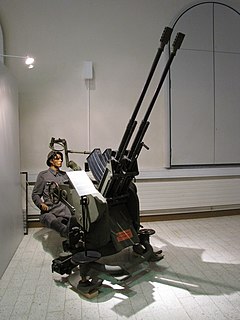 W
WThe 20 ItK 40 VKT or 20 mm dual anti-aircraft cannon model 1940 manufactured by VKT was a Finnish light anti-aircraft gun designed by the Finnish gunsmith Aimo Lahti. As the only multi-barrel 20 mm anti-aircraft gun 20 ItK 40 VKT was the most effective 20 mm air defence weapon used by the Finnish Army during World War II. A total of 174 guns were built, used in training until the 1970s and kept in reserve until 1988. The gun received the nickname Vekotin (gadget) from Finnish soldiers. The nickname was reached by adding to the abbreviation of manufacturer, VKT.
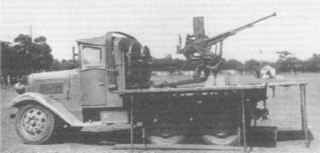 W
WThe AA Machine Cannon Carrier truck was a self-propelled anti-aircraft gun of the Imperial Japanese Army. It consisted of the Type 98 20 mm AA machine cannon mounted on the back of a Type 94 6-Wheeled Truck. The Type 94 truck was first produced in 1934 by Isuzu, and used for prototypes. It was known to be reliable and was produced in "large numbers".
 W
WThe 20 mm modèle F2 gun is a naval defence weapon used by the French Navy. It was developed from the GIAT M693. It fires the 20×139 mm round originally developed for the Hispano-Suiza HS.820 series.
 W
WThe Polsten was a Polish development of the 20 mm Oerlikon gun. The Polsten was designed to be simpler and much cheaper to build than the Oerlikon, without reducing effectiveness.
 W
WThe 20×138mmB cartridge or Long Solothurn is a type of ammunition used mainly for anti-aircraft and anti-tank weapons during World War II. The designation means the caliber is 20 mm, the length of the cartridge case is 138 mm and B indicates it is a belted case. The loaded cartridge weighs 300 grams (10.7 oz).
 W
WThe Becker Type M2 20 mm cannon was a German autocannon developed for aircraft use during World War I by Stahlwerke Becker. It was first mass-produced in 1916 and was installed in a variety of aircraft. It was the only German autocannon to see service in the air during the war.
 W
WThe Berezin B-20 was a 20 mm caliber autocannon used by Soviet aircraft in World War II.
 W
WThe Cannone-Mitragliera da 20/65 modello 35 (Breda), also known as Breda Model 35, was a 20 mm anti-aircraft gun produced by the Società Italiana Ernesto Breda of Brescia company in Italy and used during World War II. It was designed in 1932 and was adopted by the Italian armed forces in 1935. It was the one of two 20-millimetre-calibre anti-aircraft guns used by Italy during World War II, the other being the 20 mm Scotti. Both weapons fired the 20x138mmB cartridge.
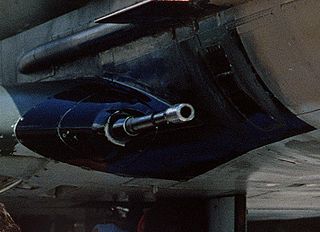 W
WThe Colt Mk 12 is a 20 mm autocannon that was widely used by the United States Navy after World War II.
 W
WThe Denel Land Systems GI-2 is an autocannon manufactured by Denel Land Systems (DLS) and used by the South African Army, Navy, Air Force, Royal Thai Navy, Indonesian Army and Navy.
 W
WThe NTW-20 is a South African anti-materiel rifle, developed by Denel Mechem in the 1990s. It is intended for deployment against targets including parked aircraft, telecommunication masts, power lines, missile sites, radar installations, refineries, satellite dishes, gun emplacements, bunkers and personnel, using a range of specialised projectiles. As with other weapons of this type, it can also be used for counter sniping and ordnance disposal.
 W
WThe Gebirgsflak 38 was a German anti-aircraft weapon of World War II, a lightweight version of the 2 cm FlaK 38 designed for airborne and mountain troops as a dual purpose gun for use against air and ground targets. The main difference was that the carriage was smaller and lighter than the carriage for the FlaK 38. The gun and carriage were designed to allow the weapon to be broken into several pack loads for transport. The carriage has two wheels and when raised the gun has a 360° traverse. Unlike the Flak 38, the light carriage is not designed for high towing speeds.
 W
WThe HS.404 is an autocannon originally designed and produced by Spanish/French company Hispano-Suiza in the mid-1930s. It was widely used as an aircraft, naval and land-based weapon by French, British, American and other military services, particularly during World War II. The cannon is also referred to as Birkigt type 404, after its designer Marc Birkigt and later versions based on British development are known as 20 mm Hispano.
 W
WThe HS.820 was a 20 mm caliber autocannon developed by Hispano-Suiza primarily for aircraft use, but more widely used in a series of ground-based anti-aircraft guns. After Oerlikon purchased Hispano's armaments division in 1970, the HS.820 became the Oerlikon KAD, supplanting Oerlikon's own KAA and KAB weapons in the process. A US-built model, the M139, saw some use on vehicles.
 W
WThe Ho-5 was a Japanese aircraft autocannon used during World War II. Developed from the Ho-103 machine gun, it was a version of the American Model 1921 Browning aircraft machine gun. It replaced the Ho-1 and Ho-3 in general service. The Ho-5 was belt-fed using typical Browning-style steel disintegrating links. The cartridge used was a shortened version of the Allied 20 x 110mm Hispano-Suiza HS.404.
 W
WThe Lahti L-39 is a Finnish 20 mm anti-tank rifle used during the Second World War. It had excellent accuracy, penetration and range, but its size made transportation difficult. It was nicknamed "Norsupyssy", and as tanks developed armour too thick for the Lahti to penetrate, its uses switched to long range sniping, tank harassment and with the L-39/44 fully automatic variant, employment as an improvised anti-aircraft weapon.
 W
WThe M39 cannon is a 20 mm caliber single-barreled revolver cannon developed for the United States Air Force in the late 1940s. It was used on a number of fighter aircraft from the early 1950s through the 1980s.
 W
WThe M61 Vulcan is a hydraulically, electrically or pneumatically driven, six-barrel, air-cooled, electrically fired Gatling-style rotary cannon which fires 20 mm rounds at an extremely high rate. The M61 and its derivatives have been the principal cannon armament of United States military fixed-wing aircraft for sixty years.
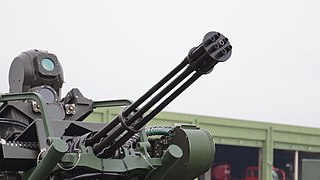 W
WThe M167 Vulcan Air Defense System (VADS) is a towed short-range United States Army anti-aircraft gun designed to protect forward area combat elements and rear area critical assets. It was also used to protect U.S. Air Force warplane airfields and U.S. Army helicopter airfields. The heart of the M167 was a variant of the M61 Vulcan 20×102 mm rapid-fire rotary cannon.
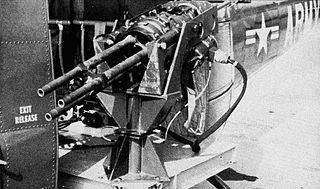 W
WThe M197 electric cannon is a 20 mm three-barreled electric Gatling-type rotary cannon used by the United States military.
 W
WThe M621 is a 20 mm automatic cannon of French design, developed by Nexter as on-board armament for armored vehicles, aircraft, helicopters and small coastal vessels of the French Navy.
 W
WThe 20 mm AA Machine Cannon M/38 was a 20 mm rapid fire autocannon produced by the Danish company Dansk Industri Syndikat (DISA). The gun, which could be adapted to several tactical uses, was a primary weapon of the military of Denmark. It was also exported to numerous countries around the world because of its versatility. The cannon was built at the DISA works in Herlev near Copenhagen. The company supplied several different types of mountings with the weapon which allowed it to be employed in a variety roles such as aerial defences, anti-tank warfare or on naval ships.
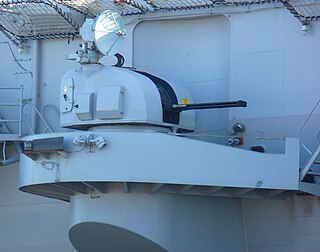 W
WThe Meroka CIWS is a Spanish Navy 12 barrelled 20 mm CIWS, using twelve Oerlikon 20 mm/120 guns mounted in 2 rows of 6 guns each. The system's primary purpose is defence against anti-ship missiles, and other precision guided weapons. However it can also be employed against aircraft, ships and other small craft, coastal targets, and floating mines. The weapon is mounted primarily on Spanish naval vessels, from frigate size upwards.
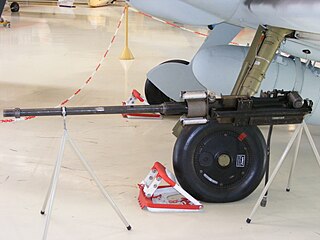 W
WThe MG 151 was a German 15 mm aircraft-mounted autocannon produced by Waffenfabrik Mauser during World War II. Its 20mm variant, the 20 mm MG 151/20 cannon, was widely used on German Luftwaffe fighters, night fighters, fighter-bombers, bombers and ground-attack aircraft. Salvaged guns saw post-war use by other nations.
 W
WThe MG FF was a drum-fed, blowback-operated, 20 mm aircraft autocannon, developed in 1936 by Ikaria Werke Berlin of Germany. It was a derivative of the Swiss Oerlikon FF F cannon, with the Oerlikon FF design itself a development of the Imperial German World War I Becker 20 mm cannon, and was designed to be used in space-limited, fixed mountings such as inside aircraft wings, although it saw use as both an offensive and a defensive weapon, in both fixed and flexible format. It saw widespread use in those roles by the German Luftwaffe, particularly during the early stages of World War II, although from 1941 onwards it was gradually replaced by the Mauser firm's 20 mm MG 151/20, which was lighter, and had both a higher rate of fire and muzzle velocity.
 W
WThe Nkm wz.38 FK was a 20 mm heavy machine gun produced in inter-war Poland. It was used both in anti-air and anti-tank role and was also adapted for tank use and mounted on some TKS tankettes. Mass-produced in 1938 and 1939, it was used extensively during the September Campaign.
 W
WThe Oerlikon 20 mm cannon is a series of autocannons, based on an original German Becker Type M2 20 mm cannon design that appeared very early in World War I. It was widely produced by Oerlikon Contraves and others, with various models employed by both Allied and Axis forces during World War II, and many versions are still in use today.
 W
WThe FF were a series of 20mm autocannon introduced by Oerlikon in the late 1920s. The name comes from the German term Flügel Fest, meaning wing mounted, fixed, being one of the first 20mm guns to be small and light enough to fit into a fighter aircraft's wing. The FF series inspired many 20mm cannon used in World War II, including the Hispano-Suiza HS.404, the German MG FF, and the Japanese IJNAS's Type 99 cannon.
 W
WThe Oerlikon GAI-BO1 is a Swiss designed and built light anti-aircraft gun which is mounted on a two-wheeled carriage with three folding outriggers. Due to its light weight and ability to be broken down into small loads it can also be mounted on ships and vehicles.
 W
WThe Phalanx CIWS is a close-in weapon system for defense against incoming threats such as small boats, surface torpedoes, anti-ship missiles and helicopters. It was designed and manufactured by the General Dynamics Corporation, Pomona Division, later a part of Raytheon. Consisting of a radar-guided 20 mm (0.8 in) Vulcan cannon mounted on a swiveling base, the Phalanx has been used by the United States Navy and the naval forces of 15 other countries. The US Navy deploys it on every class of surface combat ship, except the Zumwalt-class destroyer and San Antonio-class amphibious transport dock. Other users include the British Royal Navy, the Royal Australian Navy, the Royal Canadian Navy and the US Coast Guard .
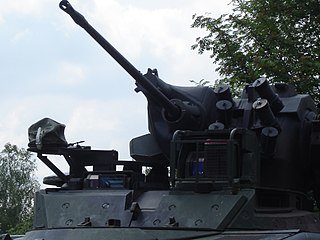 W
WThe Rheinmetall Mk 20 RH-202 is a 20 mm caliber autocannon designed and produced by Rheinmetall. It fires the 20×139mm ammunition originally developed for the Hispano-Suiza HS.820.
 W
WThe Solothurn ST-5 is a 20 mm anti-aircraft gun designed by Solothurn in Switzerland which ultimately was the design basis for the highly successful 2 cm FlaK 30 series of guns used by Germany in World War II.
 W
WThe Type 2 20 mm AA machine cannon was a Japanese-designed anti-aircraft gun, based on the German Flak 38. It entered service in 1942.
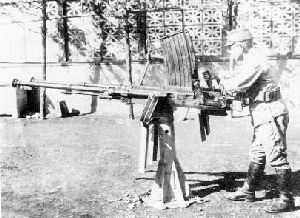 W
WType 4 20 mm twin AA machine cannon was an Imperial Japanese Army (IJA) anti-aircraft gun. It consisted of two Type 98 20 mm AA machine cannon. It was introduced in 1944 and approximately 500 guns were produced.
 W
WThe Type 98 20 mm AA half-track vehicle was an experimental Japanese self-propelled anti-aircraft gun. It had a single 20 mm Type 98 AA cannon mounted on the back section of a Type 98 4-ton half-track. The modified vehicle used was designated the Type 98 Half-tracked Prime Mover Ko-Hi. The Type 98 Ko-Hi was first manufactured in 1938 by Isuzu.
 W
WThe Type 98 20 mm AA machine cannon was the most common light anti-aircraft gun of the Imperial Japanese Army. It entered service in 1938 and was used until the end of World War II. After World War II this gun was used by the Indonesian Army in the Indonesian National Revolution and North Vietnam in First Indochina War.
 W
WThe Type 98 20 mm AAG Tank was a Japanese self-propelled anti-aircraft gun using a twin Soki Type II 20 mm anti-air gun. They were combined with the chassis of the Type 98 Ke-Ni. The gun crew worked from a raised platform with a modest amount of protection from the sides - the twin 20 mm gun fired through a large Gun shield gave further protection for the crew from that direction.
 W
WVidhwansak is an Indian multi-caliber anti-materiel rifle (AMR) or large-caliber sniper rifle manufactured by Ordnance Factory Tiruchirappalli. It can be used in the anti-materiel role for destroying enemy bunkers, lightly armoured vehicles, radar systems, communication equipment, parked aircraft, fuel storage facilities, etc. It is also effective in long-range sniping, counter sniping and ordnance disposal roles.